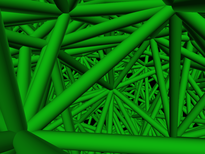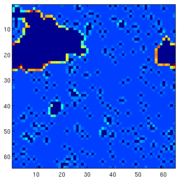Rupture cascades in a discrete element model of porous sedimentary rocks
Understanding the processes that lead up to catastrophic failure in porous granular media is an important problem in a wide variety of applications, notably in Earth sciences and engineering. In natural catastrophes such as landslides and earthquakes, as well as in controlled laboratory tests on rock samples, the available data are incomplete, and provide only a limited insight into the complexity of the key microscopic processes at work prior to failure.
On the other hand computer models can simulate all of the processes at work, right down to the minutest detail. Motivated by this potential, we developed a new computer model of the compressive failure of porous rocks. First we reconstruct a model rock of discrete elements by sedimenting spherical particles, wathing them fall and settle under gravity. Then we 'cement' them together at the points of contact with breakable beams.
 |
Final reassembled samples of the simulationsA cylindrical sample of model sand stone was subject to uniaxial compression until it completely failed. In the final state we reassembled the sample by placing the particles back to their original position inside the body. In the left figure particles are colored according to the size of the fragment they belong to. The formation of a damage band can be observed. In the right figure only the two biggest fragments are presented so that the damage band appeares as an empty region. |
As stress is applied the local contacts break, increasingly as cascades of correlated micro-fractures. The model overcomes some problems associated with simpler computational models and spontaneously reproduces the observed scaling laws of rupture cascades in natural and experimental data remarkably well. The new understanding of the relationship between microscopic processes and properties that can be observed at a bigger scale hold out the potential for developing better predictive models for catastrophic failure.
References
1. F. Kun, I. Varga, S. Lennartz-Sassinek, and I. G. MainRupture Cascades in a Discrete Element Model of a Porous Sedimentary Rock
, Physical Review Letters 112,
065501 (2014). Highlighted in
Physics Focus
b>2. F. Kun, I. Varga, S. Lennartz-Sassinek, and I. G. MainApproach to failure in porous granular materials under compression
, Physical Review E 88, 062207 (2013).
Highlighted in
Physics Focus
In collaboration with
Ian G. Main and Sabine Lenartz-Sassinek, University of Edinburg, UK
News

Science on our PNAS paper
Our paper as Editors' Suggestion
Our paper as Editors' Suggestion
Index on our work
Paper in Scientific Reports
New paper in PRL
Highlighted in Physics Focus
Associate Editor of Frontiers in Physics
Radio interview on our work
Index on our research
On the cover of PRL
Research Highlights





